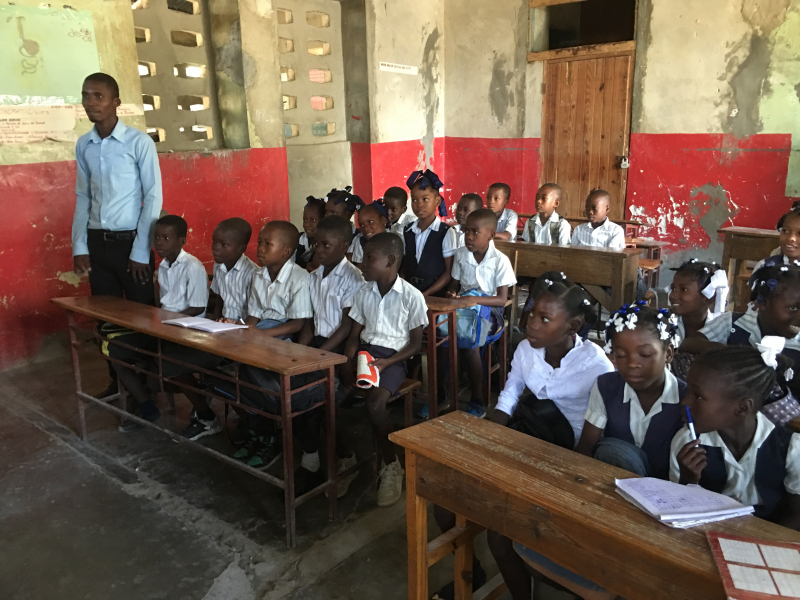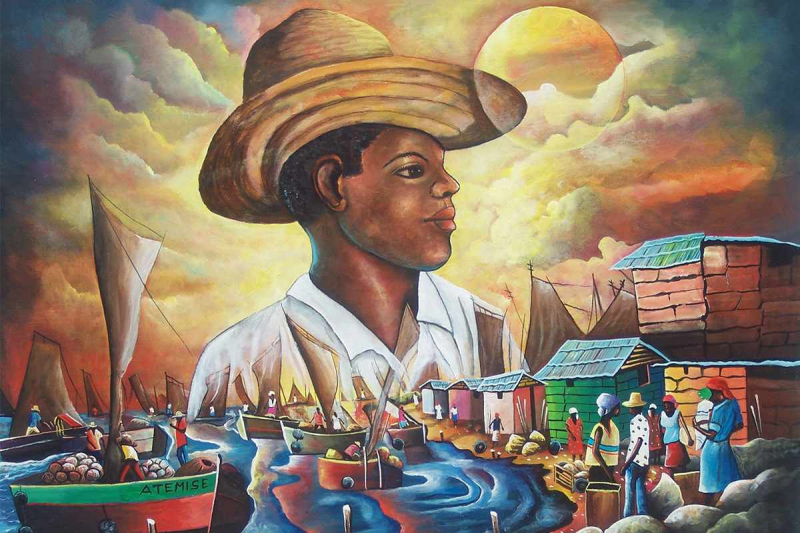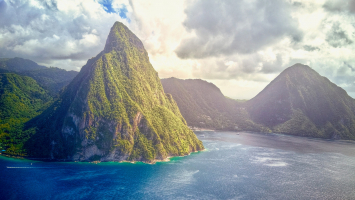Top 13 Unique Cultural Characteristics In Haiti
Haiti is a Caribbean country that encompasses the western third of Hispaniola as well as smaller islands such as Gonâve, Tortue (Tortuga), Grande Caye, and ... read more...Vache. Port-au-Prince is the capital. Haiti, whose population is nearly completely derived from African slaves, gained independence from France in 1804, becoming the second country in the Americas to do so after the United States. However, economic, political, and social difficulties, as well as a number of natural calamities, have plagued Haiti for generations, causing persistent poverty and other major problems. Nonetheless, this is a country with a distinct and distinct national identity. Here are some of the unique cultural characteristics of Haiti that you can learn more about.
-
Haitian Creole, also known as Creole or Kreyòl in the Creole language, is a French-based creole language spoken by 10-12 million people worldwide. It is one of Haiti's two official languages and the native language of the majority of the population. According to some sources, Haitians are the world's largest community speaking a modern creole language. Haitian Creole is also spoken in areas where Haitians have migrated, such as other Caribbean islands, French Guiana, France, Canada (especially Quebec), and the United States. It is connected to Antillean Creole, which is spoken in the Lesser Antilles, as well as other creole languages based on French.
The use of, and education in, Haitian Creole has been a source of contention since at least the nineteenth century. Some Haitians see French as a colonial heritage, whilst francophones dismiss Creole as a poor person's French. Until the late twentieth century, Haitian presidents only spoke standard French to their fellow people, and until the twenty-first century, all education in Haitian elementary schools was in modern standard French, a second language for the vast majority of their students.

https://haiti-literacy.org/ 
https://globalpressjournal.com/ -
Haiti, like the rest of Latin America, is a largely Christian country, with 80% Roman Catholics and around 16% Protestants. There is a small Muslim and Hindu population in the country, primarily in Port-au-Prince. This can be seen as one of the Unique Cultural Characteristics In Haiti you should know.
Despite the terrible connotation that it has both inside and outside the country, Vodou, which includes of a blend of Central and Western African, European, and Native American (Tano) religions, is widely practiced. Vodou is a widespread syncretic religion that combines the Yoruba religion of enslaved Africans with Catholicism and some Native American strands; it shares several deity-saints with Cuban Santera and Brazilian Candomblé.
The actual number of Vodou practitioners is unknown; nevertheless, it is assumed that a sizable portion of the population practices it, frequently in conjunction with their Christian beliefs. Some secular Christians have been known to participate in some rituals, albeit in an indirect manner. The Haitian constitution guarantees religious freedom but does not constitute a national religion, while the Catholic Church is given preferential treatment.

https://www.nytimes.com/ 
https://en.wikipedia.org/ -
The most notable landmarks in Haiti are the Sans-Souci Palace and the Citadelle Laferrière, both of which were designated World Heritage Sites in 1982. The constructions date from the early nineteenth century and are located in the Northern Massif de la Hotte, one of Haiti's National Parks. The structures were among the first to be constructed following Haiti's independence from France. The 2010 Haiti earthquake severely damaged Jacmel, the colonial city that was tentatively accepted as a World Heritage site.
Architecture has changed dramatically since the 2010 earthquake. With anticipated damages of $10 million, architectural measures were implemented immediately. In the immediate aftermath of the earthquake, Article 25 of the United Kingdom recruited approximately 350 architects to assist in the reconstruction of Haiti. The United States also provided a significant contribution through the Architecture for Humanity initiative, which was launched in the aftermath of the earthquake. The architecture style became quite rational, involving a basic and practical style to aid in the most effective reconstruction of the damage. There has also been a major push to create more open-air clinics with health precautions as a top emphasis.

https://archello.com/ 
https://buildabroad.org/ -
Haitian literature has long been interwoven with Haitian politics. Haitian intellectuals looked to African traditions, France, Latin America, the United Kingdom, and the United States, either sequentially or concurrently. At the same time, with its heroes, upheavals, cruelties, and rites, Haitian history has always been a rich source of inspiration for writing.
In the eighteenth century, settlers in France created descriptive and political works. Pétion Gérome founded the magazine La Ronde in 1895, ushering in the new century. The poets of this small and delicate style continued to draw inspiration from France. This style was continued in the early twentieth century by poets such as Dantès Bellegarde and Ida Faubert. Many Haitian academics fled during the Duvalier tyranny. The so-called diaspora writers participated in militant literature, approaching Haiti in terms of memory, anguish, and guilt at being separated from one's homeland.
The collective work Acte de l'Indépendance de la République d'Haiti was the first piece of Haitian literature (Haitian Declaration of Independence). Since then, Haitian literary culture has grown and thrived, with award-winning authors and large-scale literary events held both locally and globally.

https://fivebooks.com/ 
https://electricliterature.com/ -
Haitian art is a complicated legacy that combines African roots with considerable aesthetic and theological influences from Indigenous, American, and European cultures. It serves as a significant reflection of Haitian culture and history.
Many artists congregate in painting "schools," such as the Cap-Hatien School, which depicts city life, the Jacmel School, which reflects the steep mountains and bays of that coastal town, or the Saint-Soleil School, which is distinguished by abstracted human forms and is heavily influenced by "Vaudou" symbolism.
Haitian art is distinguished by brilliant colors, naive perspective, and sly humor. This country's favorite subjects are large, tasty cuisine and gorgeous vistas. Going to the market is the most sociable activity in rural life, and it figures heavily in the subject. The African past is evoked by jungle animals, rituals, dances, and gods.
Artists also work in tale. Animals are disguised as humans, while humans are converted into animals. Symbols take on immense significance. For example, a rooster frequently depicts Aristide, and the red and blue colors of Haiti's flag frequently signify his Lavalas party. It can be seen as one of Unique Cultural Characteristics In Haiti.
https://www.widewalls.ch/ 
https://www.pomona.edu/ -
Haitian music incorporates a diverse spectrum of influences from the many people that have settled on this Caribbean island. It is influenced by French, African rhythms, Spanish elements, and others who have lived on the island of Hispaniola, as well as modest native Taino influences. Music originating from Vodou ceremonial traditions, rara parade music, twoubadou ballads, mini-jazz rock bands, rasin movement, hip hop kreyl, the enormously popular compas, and méringue as its main beat are all unique to Haiti.
Compas, short for compas direct, is a popular song today that was made popular by Nemours Jean-Baptiste on a 1955 album. The term is derived from the Spanish word compás, which means rhythm or tones. Haitian music incorporates a diverse spectrum of influences from the many people that have settled on this Caribbean island. It is influenced by French, African rhythms, Spanish elements, and others who have lived on the island of Hispaniola, as well as modest native Taino influences. Music originating from Vodou ceremonial traditions, rara parade music, twoubadou ballads, mini-jazz rock bands, rasin movement, hip hop kreyl, the enormously popular compas, and méringue as its main beat are all unique to Haiti.

https://globebids.com/ 
https://mocada.org/ -
Dancing is an essential component of Haitian culture. The religious experience of spirit possession in Vodou is usually accompanied by dancing, singing, and drumming. Carnival and rara celebrations entail frenetic dancing and movement in the streets. Dancing is also a social activity, since it is employed at church socials, informal gatherings, and evenings out with friends. Small twoubadou groups provide social dancing music in small restaurants, although larger clubs with huge dance floors frequently have dance bands the scale of American big bands.
In Haiti, social dance music is one of the most severely creolized music traditions. During the colonial period, white planter audiences were introduced to European dance traditions such as the contradanse (kontradans), quadrille, waltz, and polka. Musicians, whether slaves or freed people of color, learned and modified European dancing styles for their own purpose. The méringue was a prominent African-influenced dance style (mereng in Creole). The méringue, like the carabinier, was a favored dancing style of the Haitian elite and was a regular feature at aristocratic dances.
Mereng ouvri bal, mereng fème ba; (The mereng opens the ball, the mereng shuts the ball) refers to the méringue's popularity and prevalence as an elite amusement. The ability to dance the méringue, as well as a variety of other dances, was considered a sign of good breeding in nineteenth-century Haiti. The méringue, like other creolized dance traditions, was regarded as a representative reflection of Haitian cultural values by both elite and proletarian Haitian audiences.

https://penntoday.upenn.edu/ 
https://www.nytimes.com/ -
Carnival is the most joyous time of year in Haiti (referred to as Kanaval in Haitian Creole or Mardi Gras). This can be considered as one of the Unique Cultural Characteristics In Haiti. Haitian Carnival is an annual festival that lasts several weeks before Mardi Gras. The main annual Mardi Gras carnival in Port-au-Prince, Haiti, is known as Haitian Defile Kanaval in Haitian Creole. The celebrations begin in February. Music, parade floats, and people dancing and singing in the streets flood the cities. Carnival week is generally associated with all-night partying and a vacation from everyday life.
This is an important time for Haitian musicians to exhibit their talents and broaden their audience by performing for Carnival crowds. Rara, a holiday that comes before Easter, is also celebrated by a sizable portion of the population, and its celebration has led to it developing a form of Carnival music. Many young people also go to parties and enjoy themselves at nightclubs known as discos, as well as at Bal. This phrase is derived from the word ballad, and these events are frequently attended by large crowds.
In addition to the major carnival, Haiti conducts other carnival events throughout the year. These include Rara, a series of processions held during the Catholic Lent season that feature bands and parades similar to the larger main carnival, and Kanaval de Fleur, an annual event held on July 7th.
https://www.lipstickalley.com/ 
https://www.lunionsuite.com/ -
A Quadrille dress is a bespoke outfit worn by Caribbean women. The quadrille garment is a traditional Jamaican, Dominican, and Haitian costume. Each country has a different name for it. The dress is most commonly seen during the quadrille dance, but it is also seen on other occasions. The quadrille dress is known as a karabela dress in Haiti. The linen shirt jacket is traditional female apparel for dances, weddings, and other ceremonial occasions.
The top or bodice of this dress is usually always off-the-shoulder, with a voluminous, matching skirt. As is customary in their culture, Haitians prefer fabrics in various tones of red and blue. A Quadrille dress is a bespoke outfit worn by ladies in Caribbean countries. The quadrille dress is a Jamaican, Dominican, and Haitian folk costume. Each country has its own name for it. The dress is most commonly seen during the quadrille dance, but it is also worn on other occasions. In Haiti, the quadrille dress is known as a karabela dress.
Haitian men will frequently wear jackets and slacks that correspond to their female dancing partners in ethnic dances and for display. Haitian dress shirts, known as guayaberas, or "wedding shirts," are often made of lightweight fabrics such as linen or cotton. These shirts are frequently constructed with two closely-sewn pleats going vertically up each side of the shirt, which is typically worn untucked.
https://restavekfreedom.org/ 
https://www.pinterest.com/ -
Haiti is well-known for its folklore traditions. Many magical stories are told in Haiti as part of the Haitian Vodou tradition. Papa Doc, the Haitian dictator, was a firm believer in folklore and used portions of it to govern his violent authority over the country. This is considered as one of the Unique Cultural Characteristics In Haiti.
Haitian Vodou is a syncretic blend of Roman Catholic rituals developed during the French colonial period and ancient African beliefs, with roots in Dahomey, Kongo, and Yoruba traditions, as well as folkloric influence from Haiti's indigenous Taino peoples. The Loa, or spirits, with whom Vodouisants interact are not gods, but rather servants of the Supreme Creator Bondye.
In keeping with the faith's French-Catholic background, vodousaints are mostly monotheists, believing that the Loa are immense and powerful forces in the world with whom humans interact and vice versa, resulting in a symbiotic interaction aimed to return both humanity and the Loa to Bondye. "Vodou is a religious practice, a faith that gestures toward an intimate knowledge of God and provides its practitioners with a means to commune with the Divine through a constantly growing paradigm of dance, song, and prayers."

https://www.smithsonianmag.com/ 
https://yagbeonilu.com/ -
Football is the most popular sport in Haiti, but basketball is gaining ground. Haitians are absolutely obsessed with football. The streets of Port-au-Prince are frequently packed with underprivileged Haitians playing football with whatever they can get their hands on because football is so inexpensive in the country. At the local level, hundreds of tiny football clubs participate. Stade Sylvio Cator is a multi-purpose stadium in Port-au-Prince, Haiti, with a capacity of 30,000 spectators that is now used primarily for association football matches.
The sport is not regarded a religion, as it is in Brazil, but it is nonetheless extremely popular. Many Haitian children, teenagers, and even adults spend the majority of their leisure time participating in the sport, despite the lack of suitable facilities. Because the country is impoverished, players must make do with whatever they can find to participate in the sport. Former NBA players from Haiti include Samuel Dalembert and Olden Polynice. In the 1950 FIFA World Cup, Haitian footballer Joseph Gaetjens played for the United States national team, scoring the game-winning goal in a 1-0 victory over England. Additionally, Cockfighting was claimed to be a popular sport in the early twentieth century, though its popularity has since diminished.

https://www.borgenmagazine.com/ 
https://www.ussoccer.com/ -
To begin with, welcoming business associates during a meeting is required as a display of respect. During a business meeting, Haitians shake hands to greet one another. You can acknowledge each other this way. It is also a good idea to hand out your business card before beginning the conversation.
In Haitian business culture, a meeting does not begin with a discussion about the business. Small conversation is common at the start of a meeting. When breaking the ice, it is safer to chat about families rather than contentious topics like politics.
While polite pleasantries are important, the same is true when it comes to saying goodbye to business associates. Shaking hands can also be done at the end of a meeting to end on a positive note. Remember that good greetings, no matter how simple they are, play an important role in establishing yourself as a businessman. If you do not want to be perceived as a snob or impolite person, always greet the other person at the beginning of the meeting. This also aids in the creation of a positive image, which can influence other people's early impressions of you. Remember that first impressions are essential since they can last a lifetime.

https://commons.wikimedia.org/ 
https://imaginemd.com/ -
Every morning, Haitians have a cup of coffee, which is always accompanied by bread and butter or peanut butter. Riz et Pois, the country's traditional rice and bean dish, is served at lunchtime as the main course. Sunday lunch will frequently include a gratin, another tribute to their French ancestry. Pasta gratin is a popular side dish. Sunday is also a good day to treat yourself to a delicious dessert. Evening meals are often basic affairs consisting of a bowl of porridge or soup. However, fritay is also frequently purchased from street sellers. Fried plantain, griot, and even barbequed chicken are on the menu.
Only after the host exclaims, "Bon appetite!" can you begin eating. Knives and forks are used in Europe. After the meal, the knife and fork are placed parallel to each other across the right side of the dish. If you leave both utensils on the dish for an extended period of time, it indicates to the waitstaff that you are finished, and your plate may be removed from you. When not holding utensils, your hands should be visible above the table: do not keep them in your lap, but instead rest the wrists on top of the table.

https://www.intrepidtravel.com/ 
https://traveltank.com/


































